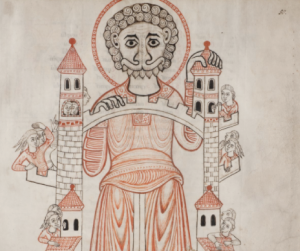My research is into the use and adaptation of the story of saint Christopher in early medieval western Europe. By ‘early medieval’ I mean from about 600 until about 1200 AD; by ‘western Europe’, I mean an area more or less equivalent to the western half of the Roman Empire, stretching (very roughly) from Sicily in the south to England in the north; from Portugal in the east to Germany in the west.
In this period, Christopher hadn’t yet become a giant man who searches for a powerful ruler to follow and ends up trying to carry the Christ child across a river before being martyred for his faith. (I think that story originated in southern Germany in the thirteenth century and became super popular shortly thereafter.) He was an individual from a tribe of cannibalistic dog-headed people who comes to know God and goes on to convert a city while being tortured and martyred. (The violence remains, though the dog-head got lost.)

Although in many ways it’s a pretty standard sort of saint’s life I think this is an interesting story for two big reasons. First, he had a dog’s head. Come on, that’s pretty interesting: a monster as a hero; a non-human teaching people how to live; an outsider bringing disturbing but ultimately positive transformation. Second, he wasn’t from anywhere identifiable to people in western Europe and had no relics (things that could be connected with his physical existence) anywhere in the west; unlike many saints, he didn’t have a local centre promoting his legend and making sure it was popular. Many – perhaps most – saints and their relics were essentially used as a form of tourist attraction; the equivalent of a minor town promoting some object they’ve found that Churchill once touched. That Christopher had none of that suggests (to me) that where his story was read and adapted, it was because people found him and his story of intrinsic value.
Most of my work, then, involves looking at different copies of the legend from my period. There’s over a hundred of them (that I’ve identified so far) in various places across Europe. When I find them, I read them, copy them out, and compare them with other versions. I’m interested in what’s been changed – deliberately or accidentally – and what difference it makes to the story. I’m also interested in what sort of collections the story is put into, and whether that makes any difference to its ideas or impact. In the end, I hope to be able to produce editions of the various versions – perhaps a digital edition of all of them if I can. And to build a database showing the contents of manuscripts containing saints’ lives, so I and others can ask similar questions about other saints. And to produce a study of different uses of the same story in different places and different times.
This is not going to change the world. In many ways, it’s exactly the sort of thing that Robert Halfon MP thinks is a waste of time. I get that (though I don’t understand why he doesn’t apply the same criteria to other things in life). But I still think it’s both exciting and worthwhile. Partly because stories are, fundamentally, what we’re made out of, and both the base story of Christopher and the story of the development of his legend are pretty good ones. Partly because holding a thousand-year-old piece of goat skin and seeing how it’s been touched, scratched, and marked allows me to connect with other humans who lived unimaginably different lives, and attempt to share that connection with my students and readers. But also because, done well, this project should form a tiny, tiny part of building towards a deeper understanding of how communities use stories to shape and think about themselves and their world.